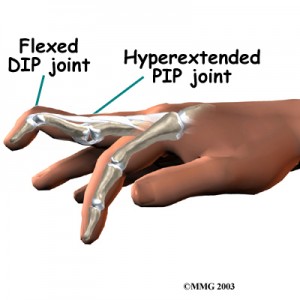 It can happen in an instant. You are reaching to catch a ball and suddenly you feel massive pain in your finger and are stunned for a second. This is a common occurrence in most sports including basketball and football. Some injuries are minor requiring little treatment and some are major requiring surgery. It is imperative to assess for an exact diagnosis and treat sooner than later to obtain optimal results.
It can happen in an instant. You are reaching to catch a ball and suddenly you feel massive pain in your finger and are stunned for a second. This is a common occurrence in most sports including basketball and football. Some injuries are minor requiring little treatment and some are major requiring surgery. It is imperative to assess for an exact diagnosis and treat sooner than later to obtain optimal results.
A common site of injury is the middle knuckle of the hand, otherwise known as the proximal interphalangeal (PIP) joint. This is one of the most complex joints in the body, and the site of serious injuries as it involves ligament and tendon tears, dislocations and fractures.
PIP joint dislocations may occur while on the playing field. The joint can frequently be put back in place on the field but must be followed up with an examination. If a finger is hyperextended, it may involve injury to a ligament called the volar plate on the palmar side of the PIP joint, resulting in a sprain. This injury can lead to long standing symptoms which can affect function if not properly treated.
The extent of an injury may not correspond with the symptoms. A player may have significant pain, swelling and stiffness but have a minor injury whereas a player requiring surgery due to a dislocation and/or fracture may have minimal symptoms. The player should be examined by an orthopedic doctor who may choose to order an x-ray and/or an MRI to confirm the diagnosis.
Once diagnosed and treated, the hand specialist will refer the patient to hand therapy. They will work closely with the player to achieve goals of reducing edema, decreasing pain and inflammation, and increasing range of motion and strength as per protocol. Splinting and progression to taping are commonly indicated to prevent deformity and maximize healing.
PIP joint injuries are common among athletes. It is often taped and hoped that it will heal in time. If symptoms don’t resolve weeks later, then a player will see a physician. The delay in appropriate care can affect the outcome. It is in the player’s best interest to treat this injury as traumatic and be seen immediately by a hand specialist and thereafter referred for hand therapy to achieve maximum functional recovery.

